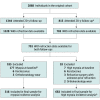Incidence and Progression of Myopia in Early Adulthood
- PMID: 34989764
- PMCID: PMC8739830
- DOI: 10.1001/jamaophthalmol.2021.5067
Incidence and Progression of Myopia in Early Adulthood
Abstract
Importance: Myopia incidence and progression has been described extensively in children. However, few data exist regarding myopia incidence and progression in early adulthood.
Objective: To describe the 8-year incidence of myopia and change in ocular biometry in young adults and their association with the known risk factors for childhood myopia.
Design, setting, and participants: The Raine Study is a prospective single-center cohort study. Baseline and follow-up eye assessments were conducted from January 2010 to August 2012 and from March 2018 to March 2020. The data were analyzed from June to July 2021. A total of 1328 participants attended the baseline assessment, and 813 participants attended the follow-up assessment. Refractive information from both visits was available for 701 participants. Participants with keratoconus, previous corneal surgery, or recent orthokeratology wear were excluded.
Exposures: Participants' eyes were examined at ages 20 years (baseline) and 28 years.
Main outcomes and measures: Incidence of myopia and high myopia; change in spherical equivalent (SE) and axial length (AL).
Results: A total of 516 (261 male [50.6%]) and 698 (349 male [50.0%]) participants without myopia or high myopia at baseline, respectively, were included in the incidences analyses, while 691 participants (339 male [49%]) were included in the progression analysis. The 8-year myopia and high myopia incidence were 14.0% (95% CI, 11.5%-17.4%) and 0.7% (95% CI, 0.3%-1.2%), respectively. A myopic shift (of 0.50 diopters [D] or greater in at least 1 eye) occurred in 261 participants (37.8%). Statistical significance was found in longitudinal changes in SE (-0.04 D per year; P < .001), AL (0.02 mm per year; P <.001), and lens thickness (0.02 mm per year; P < .001). Incident myopia was associated with self-reported East Asian vs White race (odds ratio [OR], 6.13; 95% CI, 1.06-35.25; P = .04), female vs male sex (OR, 1.81; 95% CI, 1.02-3.22; P = .04), smaller conjunctival ultraviolet autofluorescence area (per 10-mm2 decrease, indicating less sun exposure; OR, 9.86; 95% CI, 9.76-9.97; P = <.009), and parental myopia (per parent; OR, 1.57; 95% CI, 1.03-2.38; P = <.05). Rates of myopia progression and axial elongation were faster in female participants (estimate: SE, 0.02 D per year; 95 % CI, 0.01-0.02 and AL, 0.007 mm per year, 95 % CI, 0.00.-0.011; P ≤ .001) and those with parental myopia (estimate per parent: SE, 0.01 D per year; 95% CI, 0.00-0.02 and AL, 95% CI, 0.002-0.008; P ≤ .001). Education level was not associated with myopia incidence or progression.
Conclusions and relevance: These findings suggest myopia progression continues for more than one-third of adults during the third decade of life, albeit at lower rates than during childhood. The protective effects of time outdoors against myopia may continue into young adulthood.
Conflict of interest statement
Figures
References
-
- Fricke TR, Jong M, Naidoo KS, et al. . Global prevalence of visual impairment associated with myopic macular degeneration and temporal trends from 2000 through 2050: systematic review, meta-analysis and modelling. Br J Ophthalmol. 2018;102(7):855-862. doi:10.1136/bjophthalmol-2017-311266 - DOI - PMC - PubMed
Publication types
MeSH terms
LinkOut - more resources
Full Text Sources
Medical


